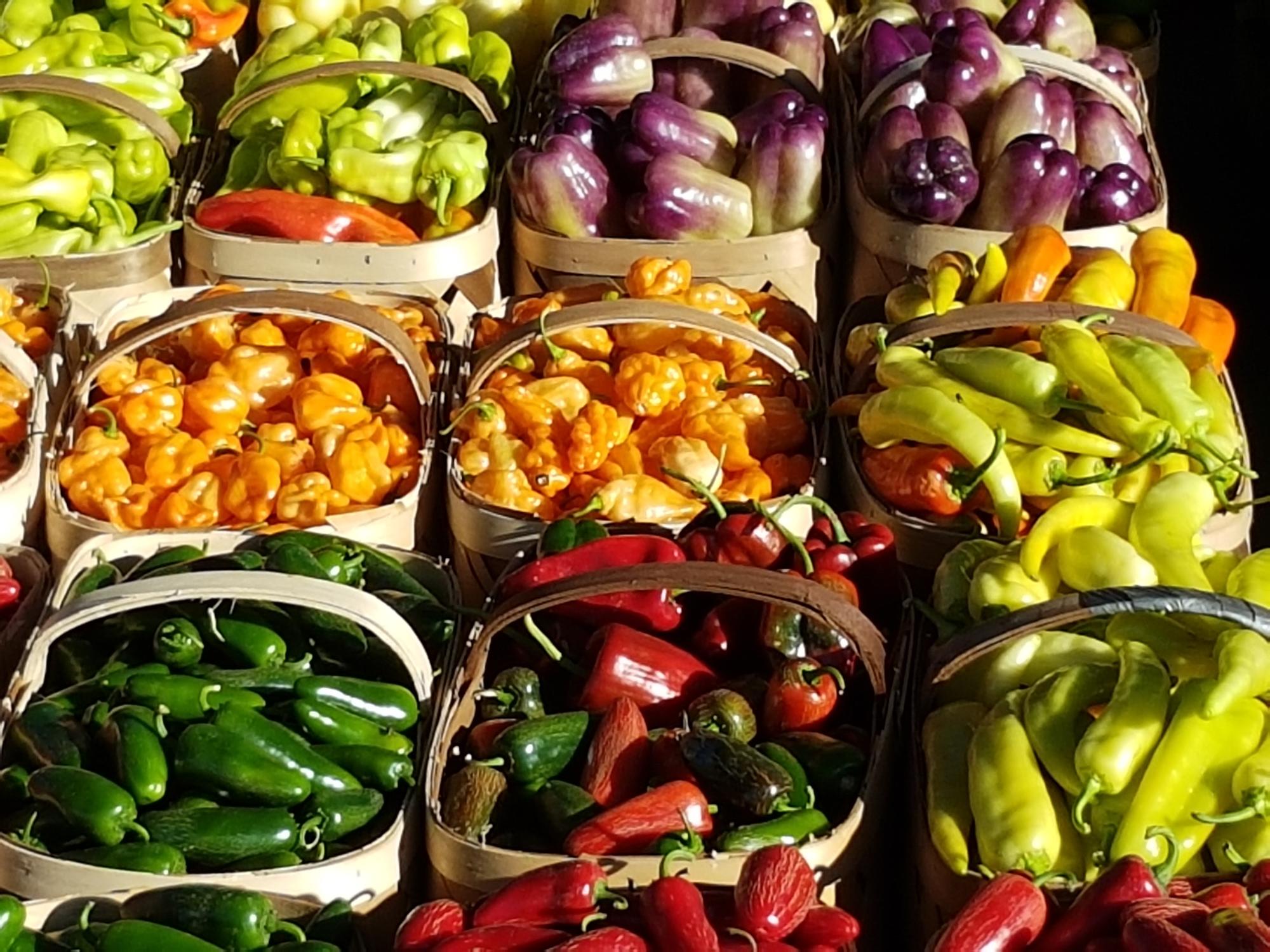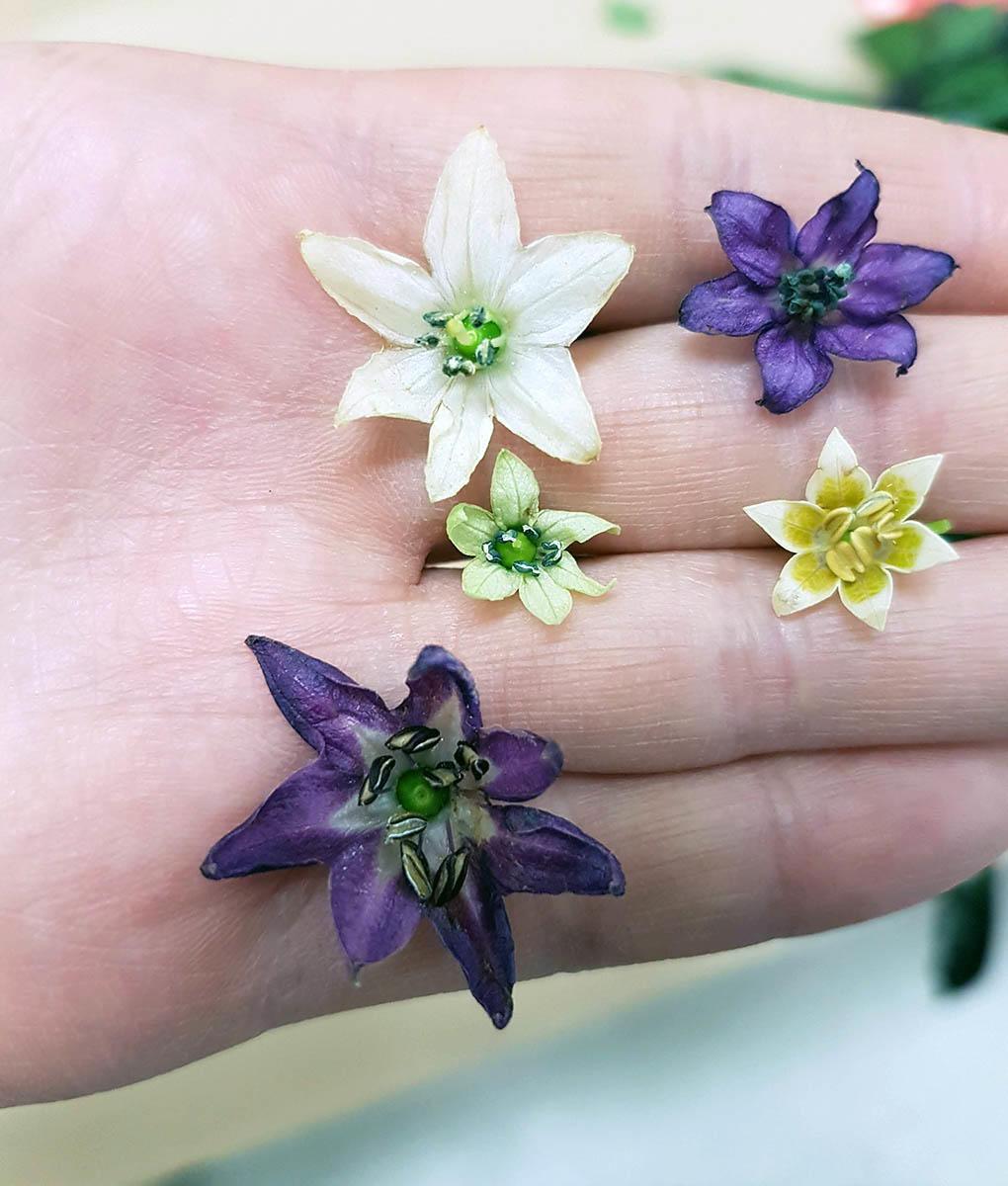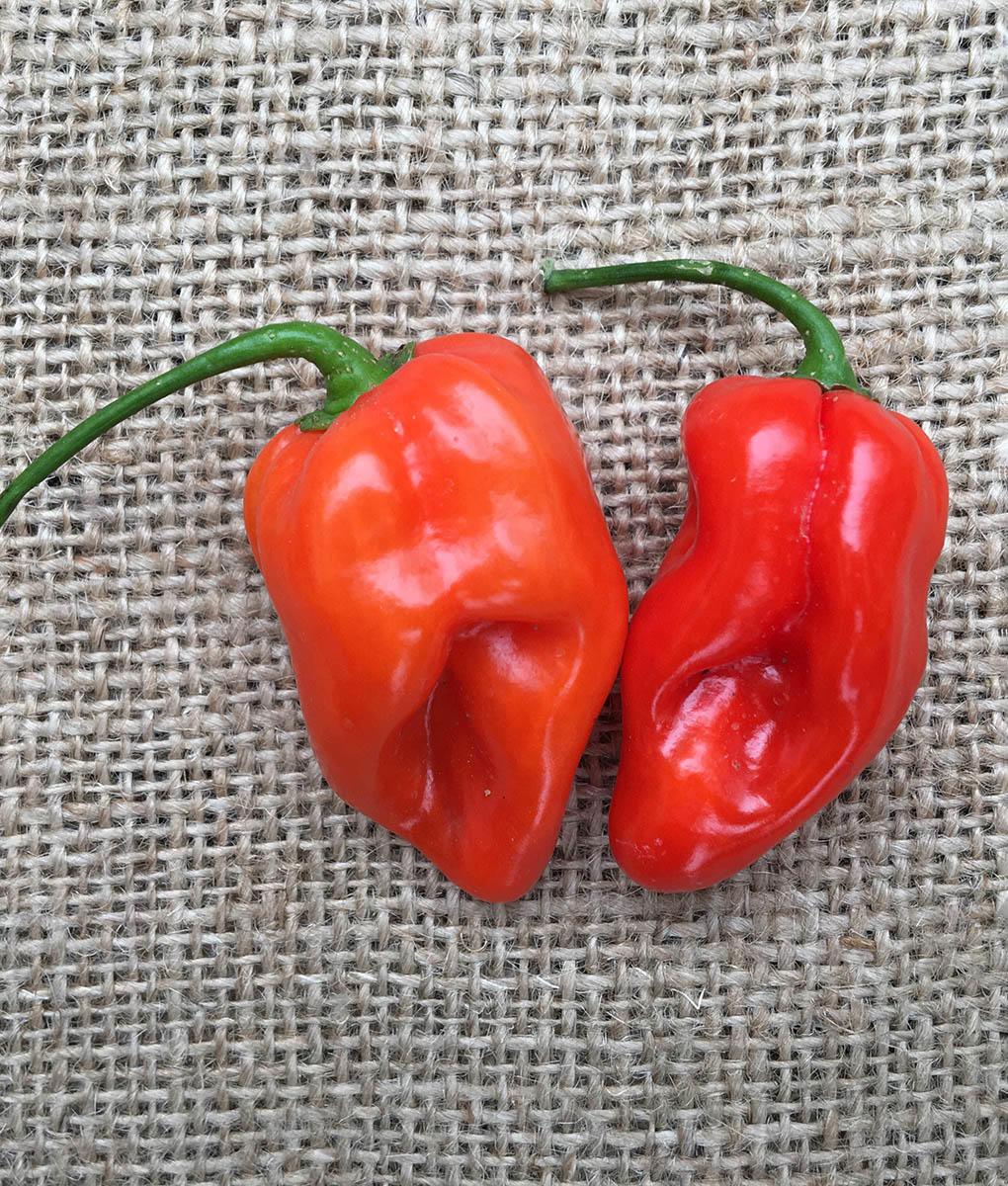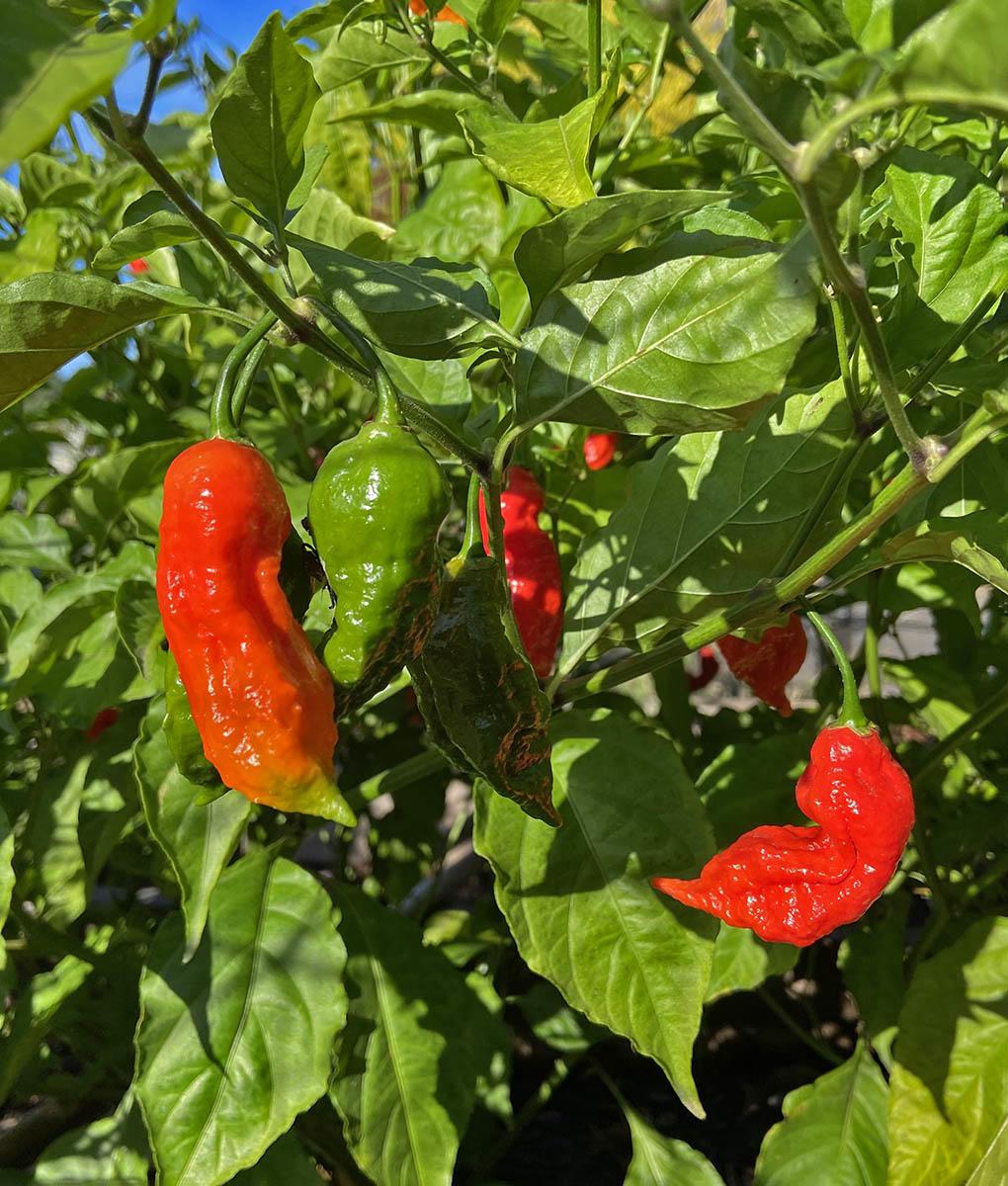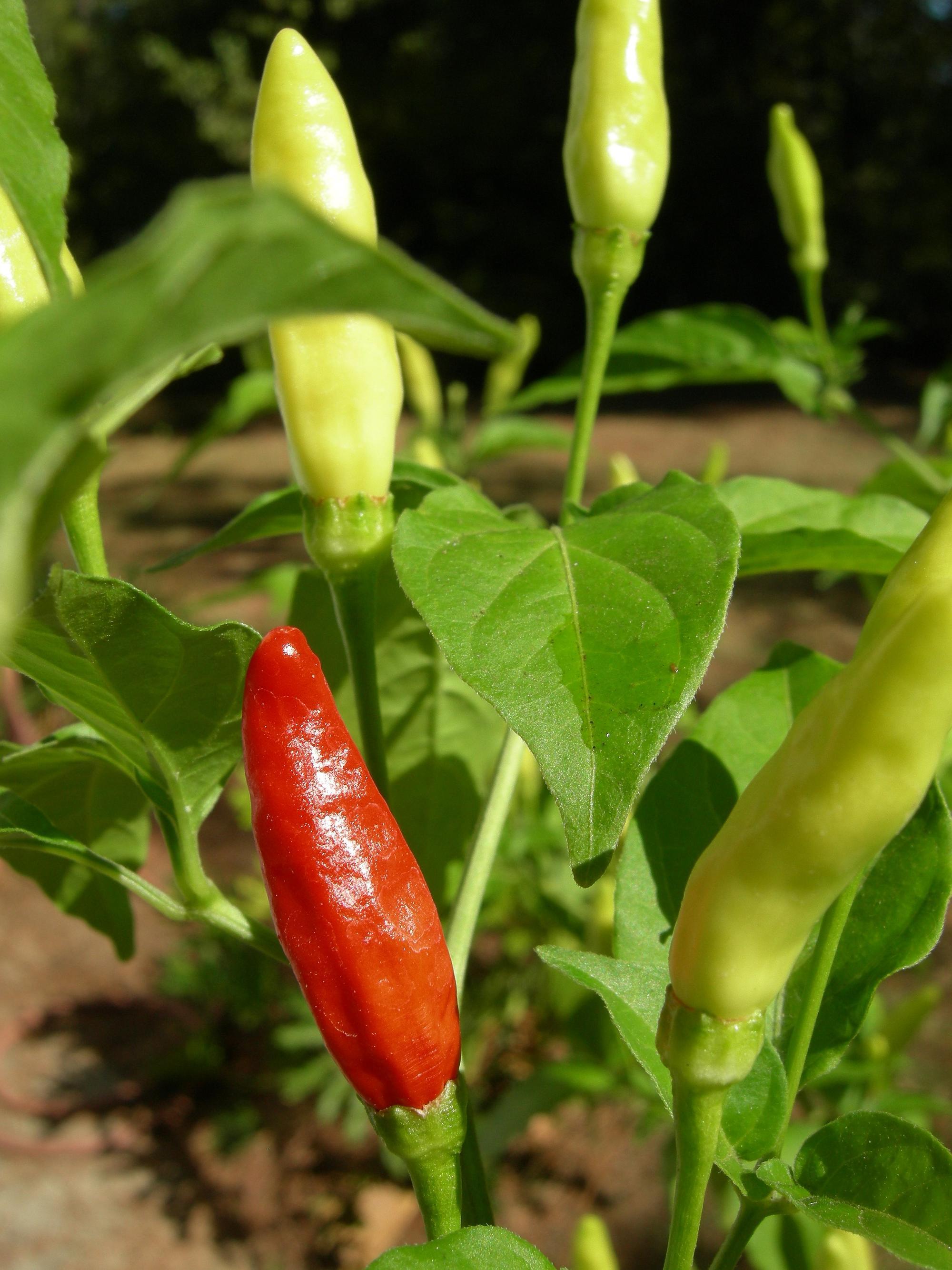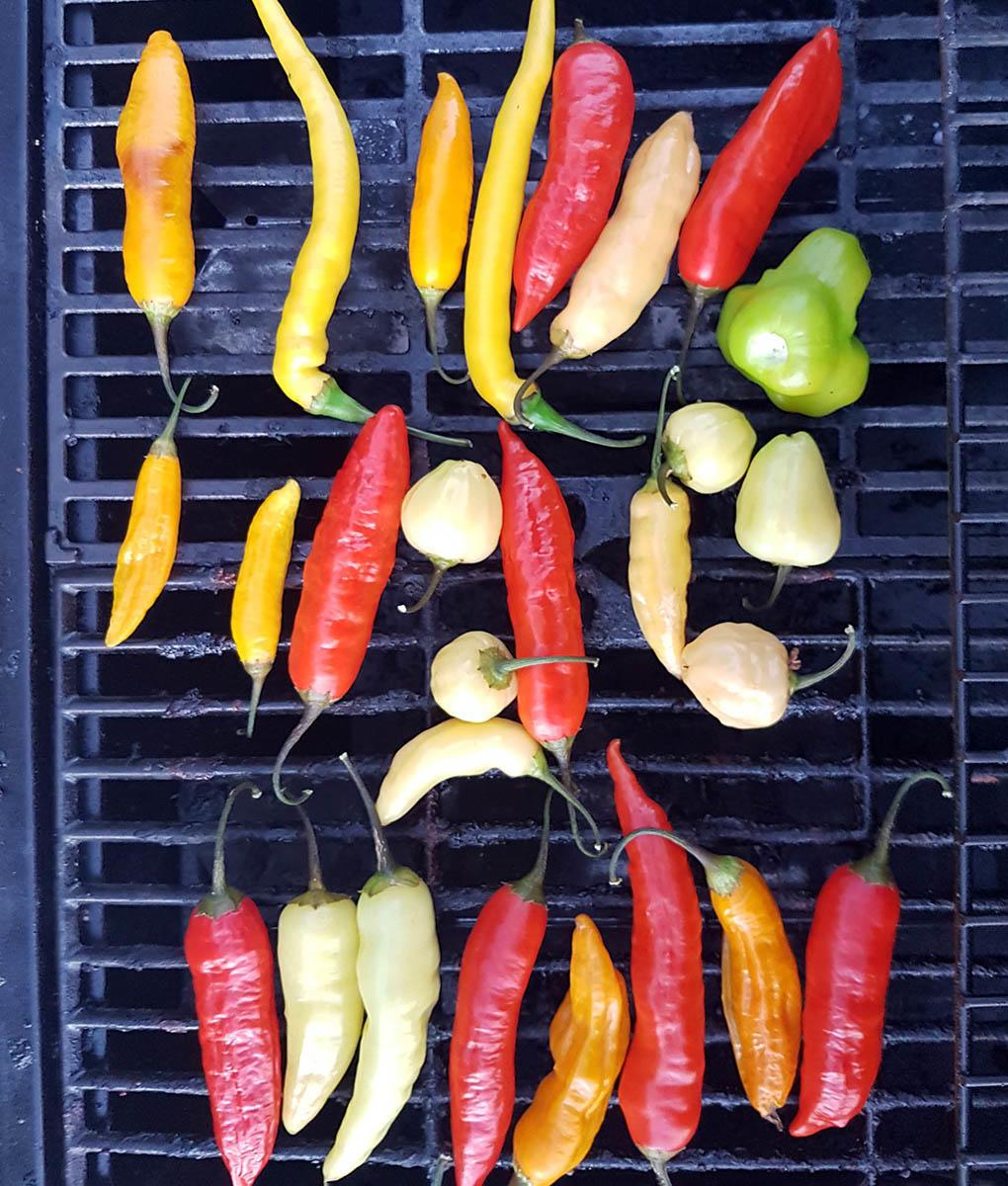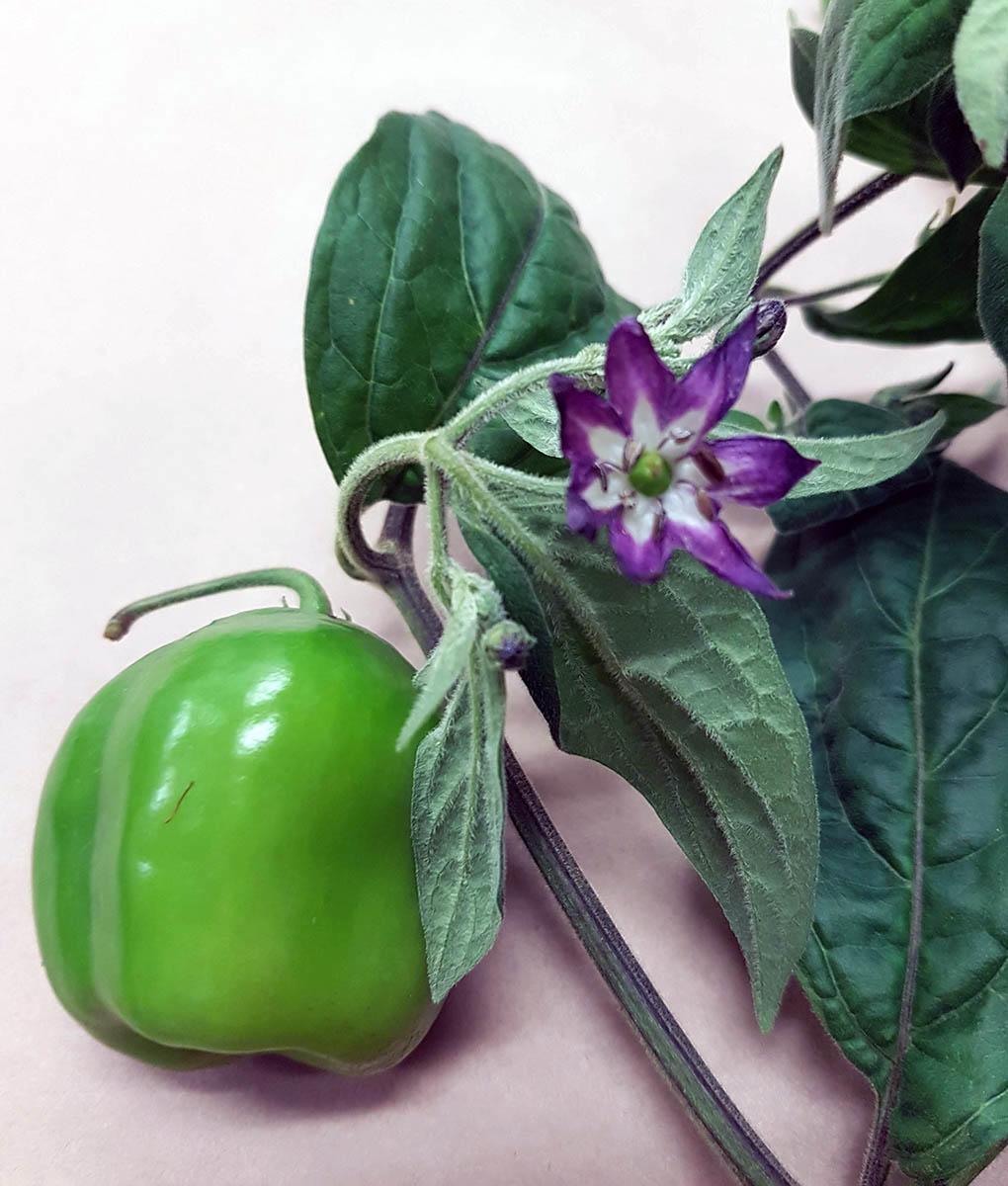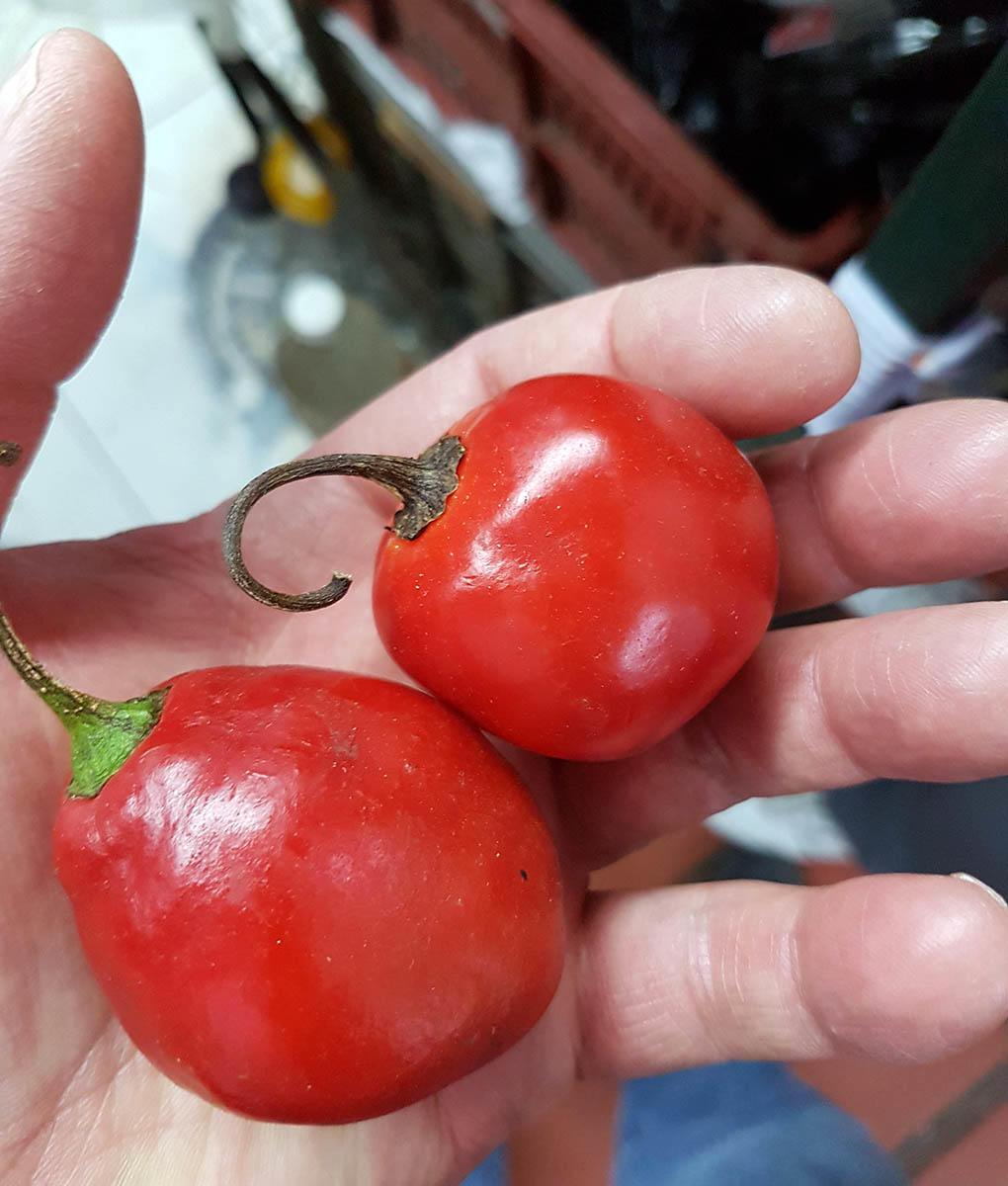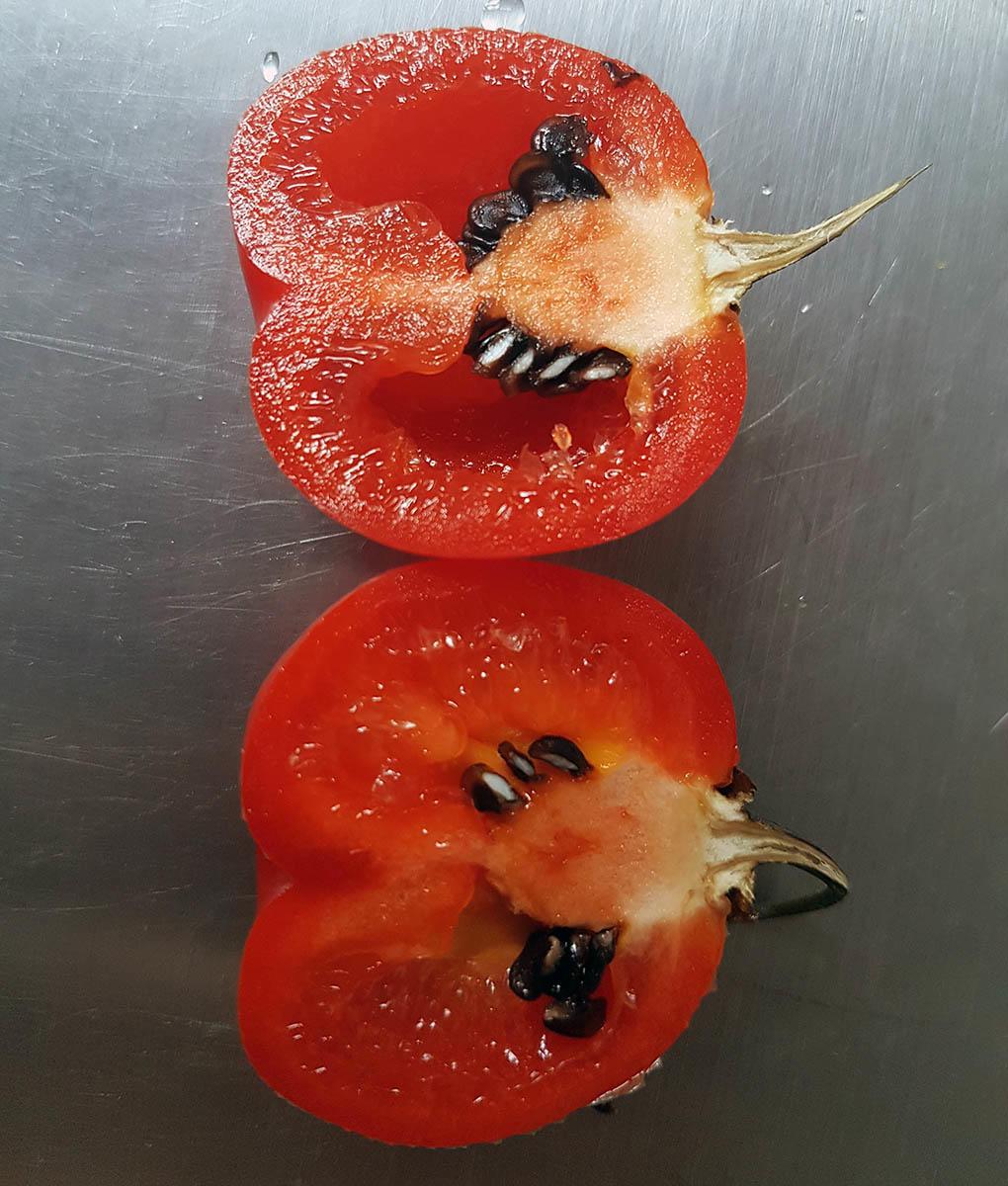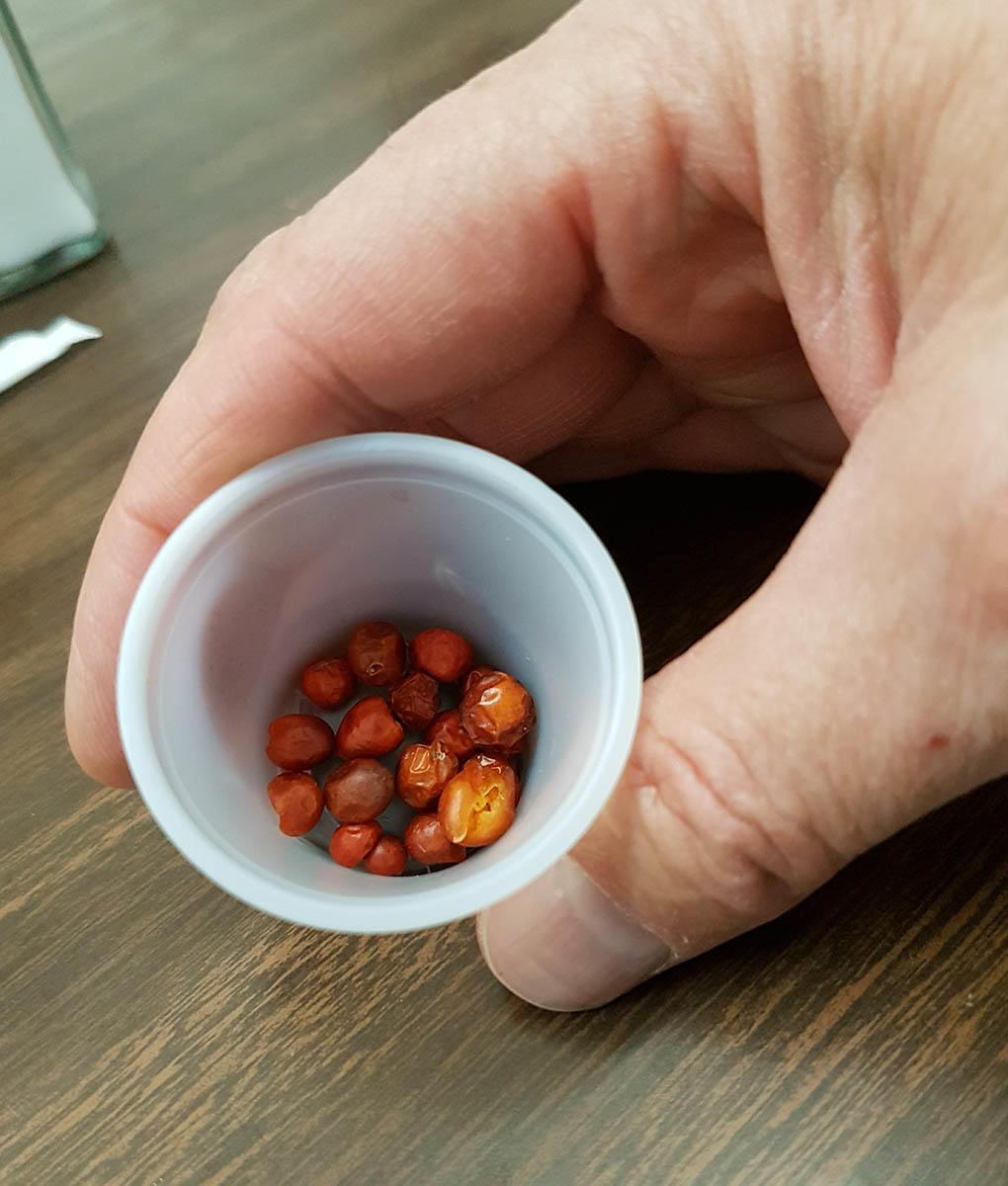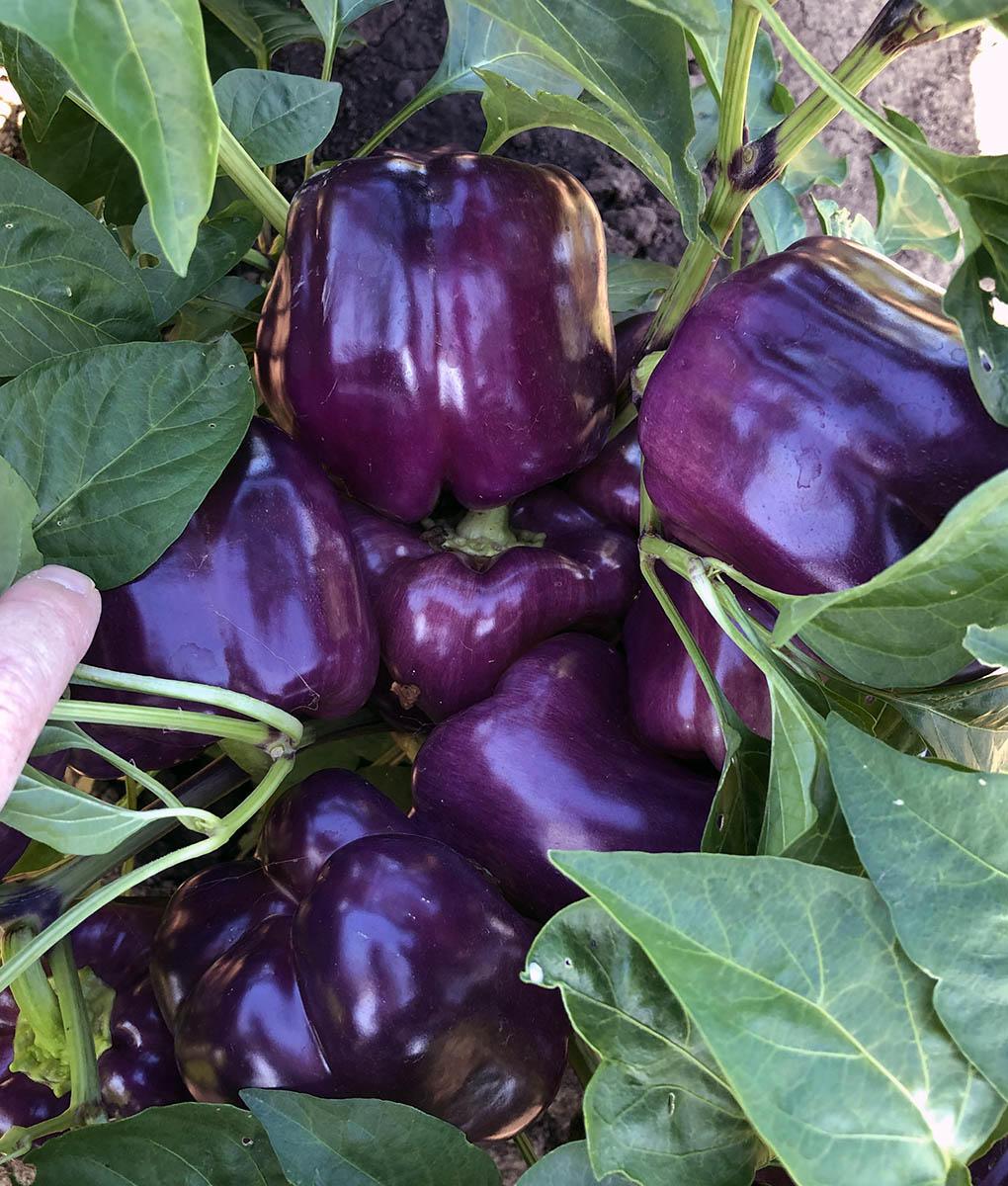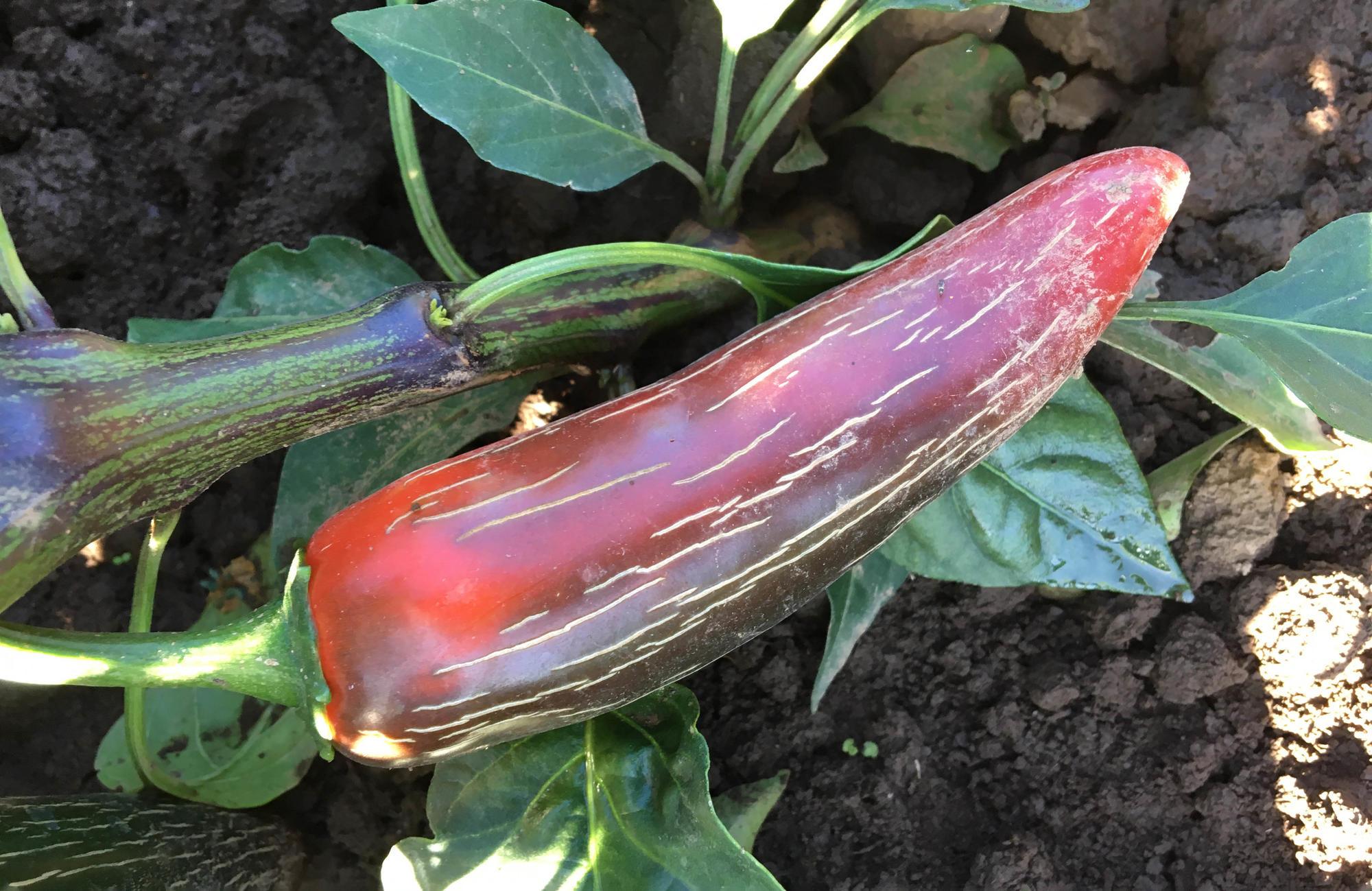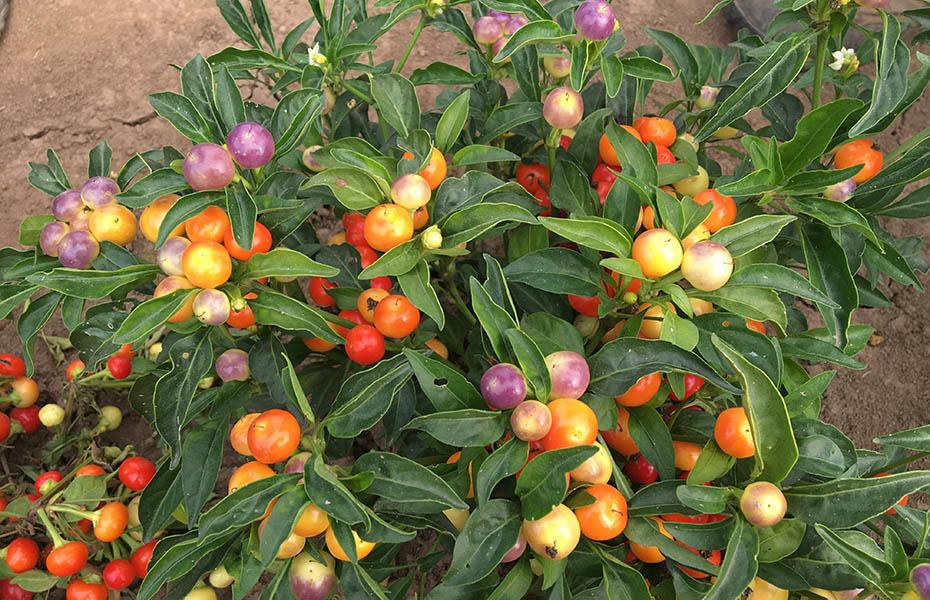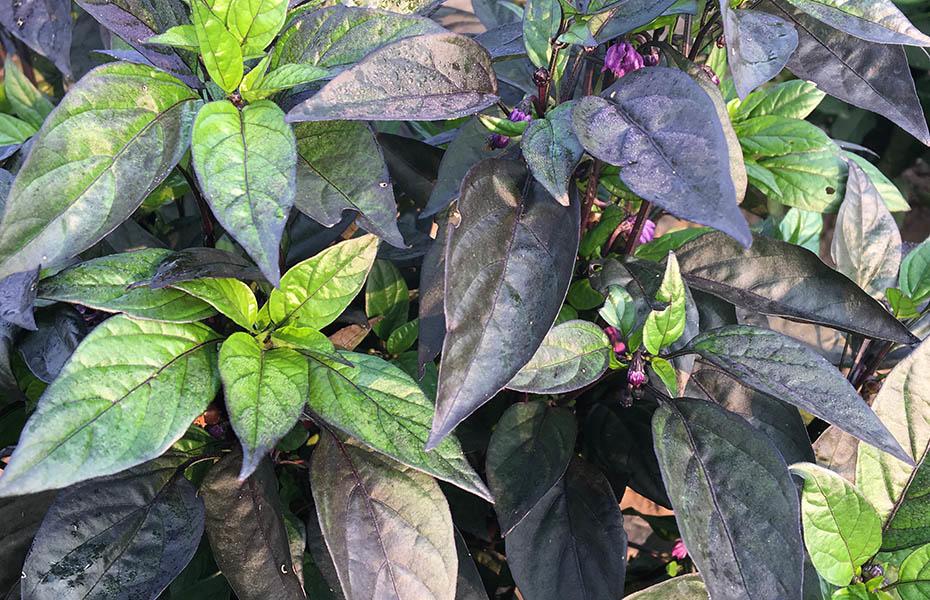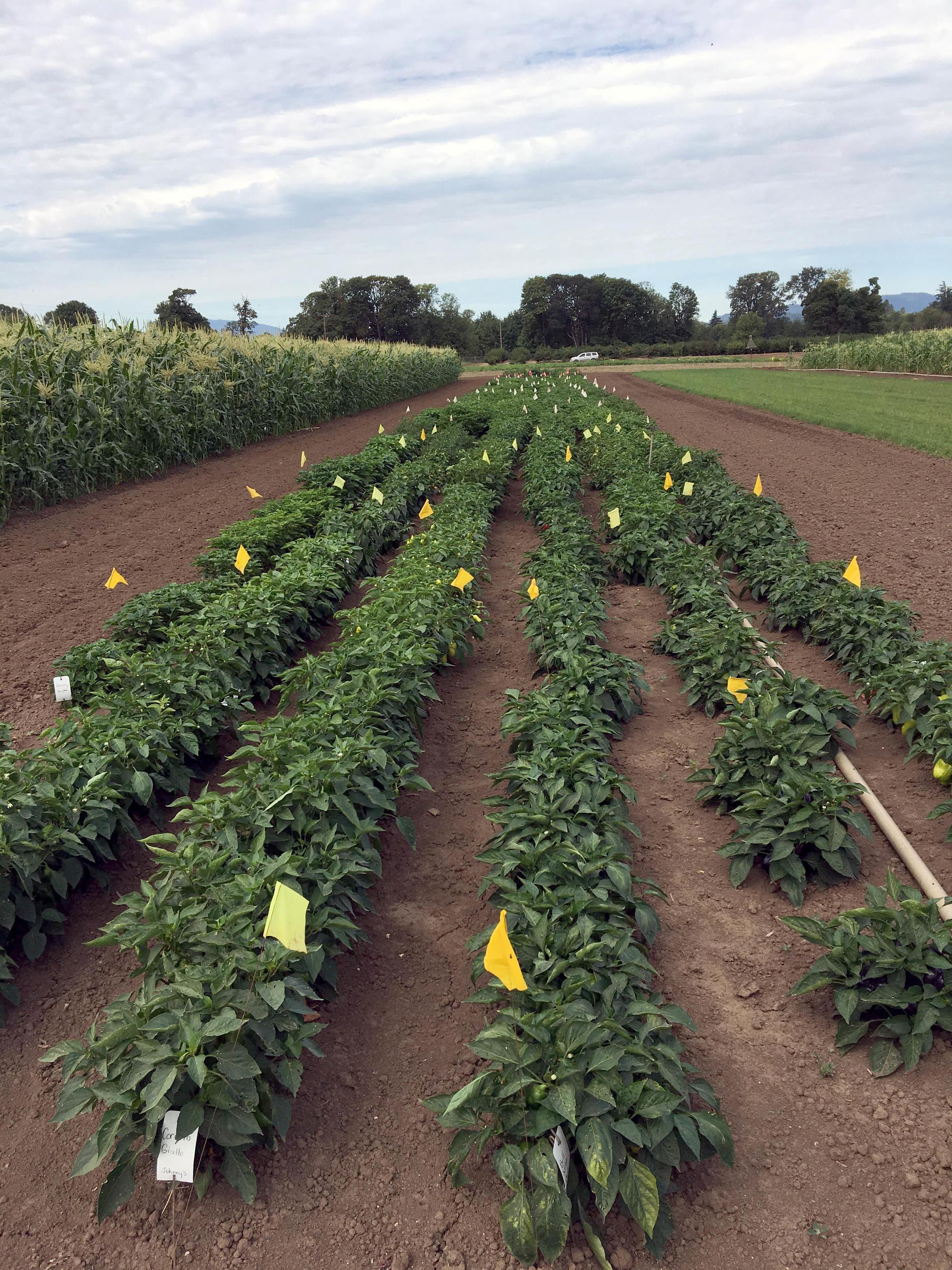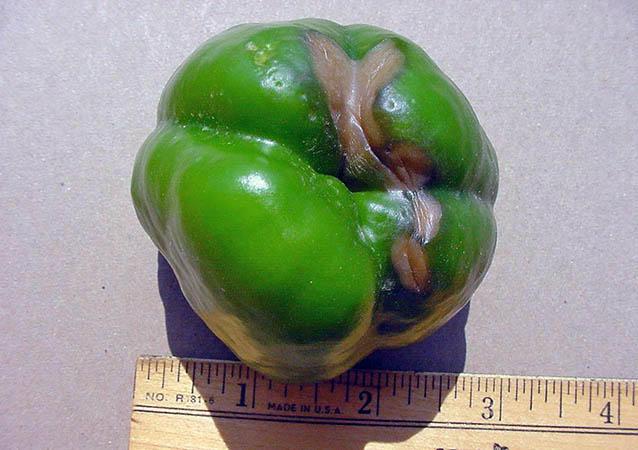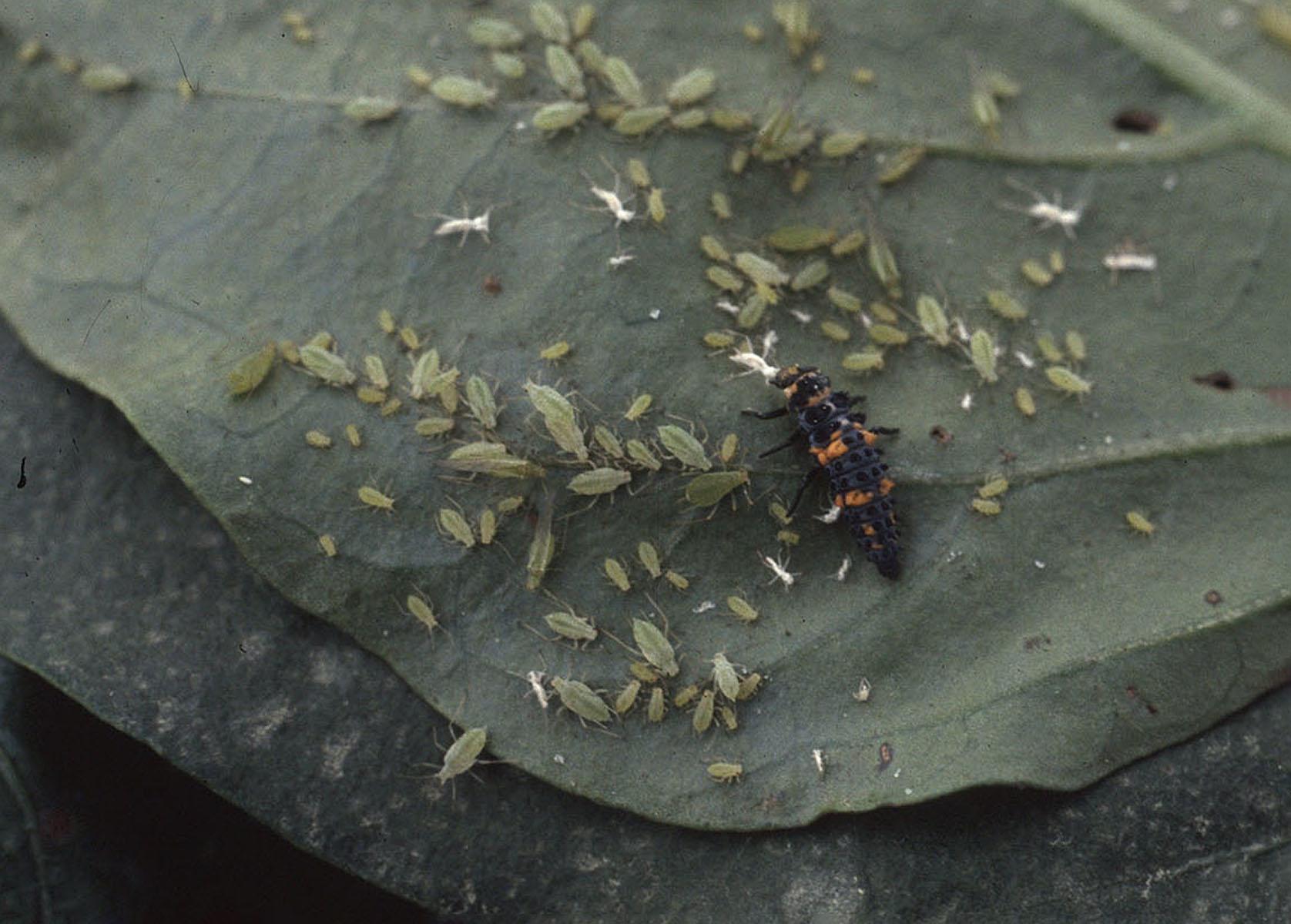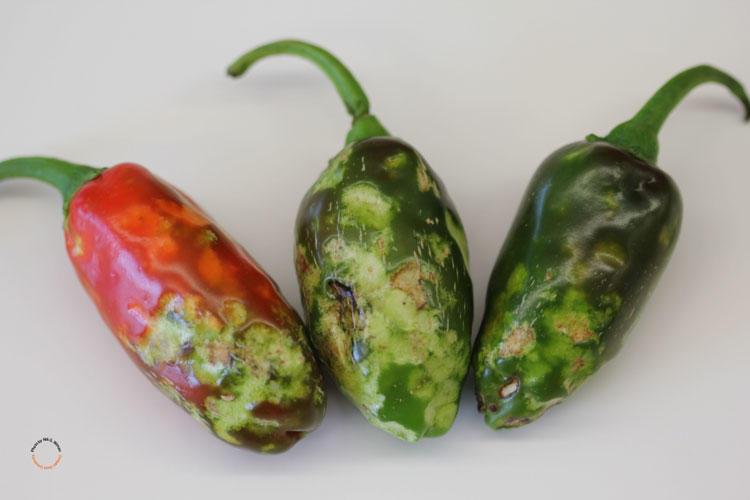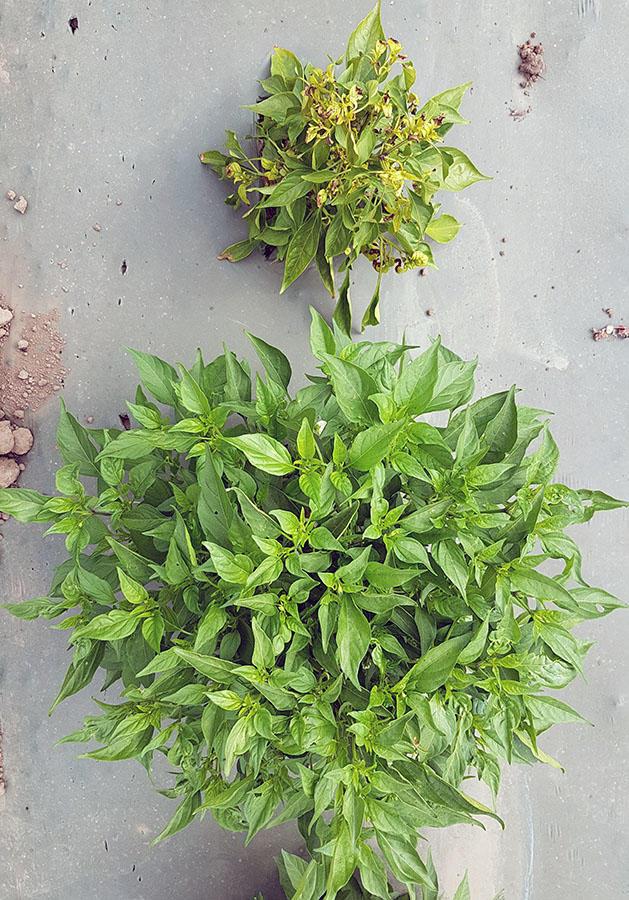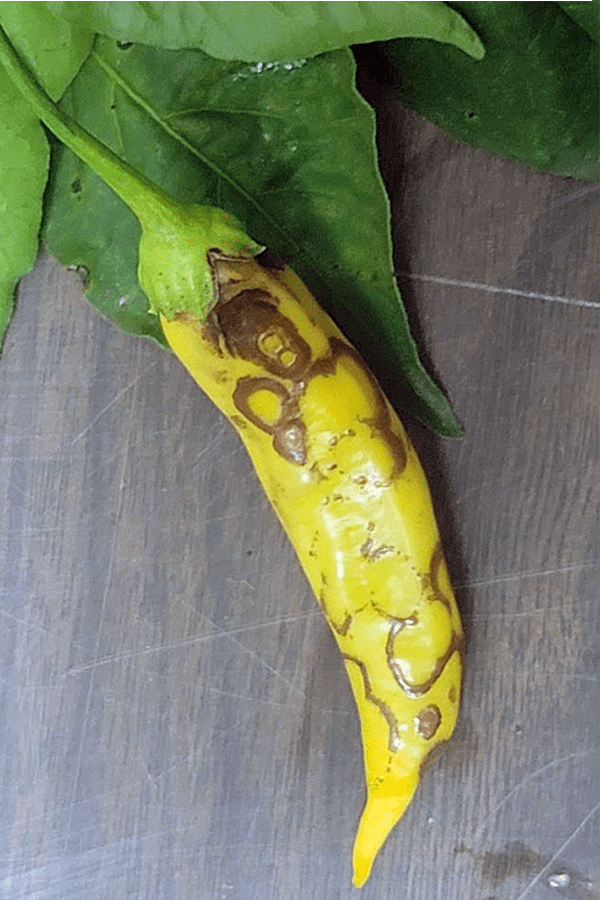Introduction
Peppers can be big like a potato or small like a bean, round like a tomato or conical like a carrot. They come in a rainbow of colors and offer an array of taste sensations. For gardeners, all this variety comes with the added bonus of a large yield in a small amount of space. This makes peppers suitable for growing in containers or other small spaces.
Peppers, known by the scientific name Capsicum, are in the same family as tomatoes, potatoes and eggplants. You can learn how to grow peppers, what they need from your soil and how to handle common problems. First, let’s look at the common species and cultivars of peppers that grow well in Oregon.
Pepper types and recommended cultivars
There are 27 known species in the genus Capsicum. Five Capsicum species are domesticated, which means they are grown in gardens and on farms. Hundreds of pepper cultivars are available to gardeners within those five species. Cultivar is short for cultivated variety.
Cultivars are bred to have the characteristics that gardeners or farmers want. Pepper cultivars come in many sizes, shapes, colors and flavor profiles. Some hold their fruit upright; others hang down.
The cultivars you can grow in Oregon depend on the growing season where you live and your use of techniques that “extend” the season. Peppers mature slowly. Under good growing conditions, peppers take at least 45 to 55 days to produce harvestable fruit after they have been pollinated. In many areas, day and night temperatures are so low that it may take an extra 15 to 20 days for the fruit to mature.
For this reason, some cultivars should not be grown where the frost-free growing season is less than 120 days. Check the “days to harvest” listed on your seed packet or in the seed catalog. This will help select the cultivar most suited to your area’s specific growing season length. Otherwise, plan to use season extension techniques like row covers, plastic mulch or a greenhouse to provide enough warmth for the fruit to mature.
Here are the key characteristics of each of the five domesticated Capsicum species and the cultivars that grow well in Oregon gardens.
Capsicum chinense (aji dulce, bhut jolokia, habañero)
This species contains the hottest pepper cultivars (100,000–1,000,000+ Scoville Heat Units, or SHU). Well-known cultivars include Scotch bonnet (habañero), Carolina Reaper (ghost pepper x habañero) and Trinidad scorpion. Ghost pepper (also known as bhut jolokia) is a hybrid (cross) of C. chinense and C. fructescens. The extreme pungency masks the wonderful, tropical, fruity aroma and flavors of these types of peppers. Low-heat cultivars that keep the traditional flavors include Biquinho Yellow, Caribbean ‘Aji Dulce’ types, Habanada, heatless habañeros, NuMex Suave (Yellow, Orange and Red) and Trinidad Perfume. C. chinense peppers originate from the Amazon region of South America and can be difficult to grow outdoors in Oregon. In the warmest parts of western Oregon, they can be grown outdoors when planted into soil covered with plastic mulch or in warm microclimates. This species will reach maximum production when grown underneath a plastic row cover, in a high tunnel or in a heated greenhouse.
Capsicum frutescens (piri, tabasco)
Peppers of C. frutescens cultivars are 1–3 inches long, slim, tapered and very hot (30,000–50,000 SHU). A popular pepper of this group is Tabasco, grown commercially for making tabasco sauce. Other cultivars in this species include African Birdseye (also known as piri or Thai Hot) and Pequin (piquín). Fruit are produced in an upright growth, making them especially attractive as ornamental plants. This species was domesticated in the humid tropical lowlands of Central America. Plant them in the warmest area of the garden and use season extension technologies (plastic row covers, greenhouse, etc.) for the best production.
Capsicum baccatum (Ají Amarillo, Bishop’s Crown, Sweet Piquanté)
C. baccatum are hot peppers with a piney to citrus-like fruity flavor (30,000 to 50,000 SHU). Fruit hang down rather than grow upright, like C. frutescens. This species shares many characteristics with C. chinense but has a unique flower color (yellow/cream with gold or green at the base). Cultivars include Aji Rico, Bishop’s Crown, Lemon Drop, Sugar Rush Hot Peach and Sweet Piquanté. C. baccatum types originate from lowland areas of southern South America. This species can be grown outdoors with season extension aids like plastic row covers, but it definitely benefits from being grown in a greenhouse.
Capsicum pubescens (locoto/manzano/Rocoto)
This hot pepper’s species name, C. pubescens, comes from the dense covering of hairs on the stems and leaves. The seeds are brown or black, unlike other Capsicum species, which have cream-colored seeds. The fruit is about 1 inch in diameter, round or bell-shaped, and red when ripe. This is a hot pepper (175,000 SHU). This species was domesticated in the Andes of northern South America. It is adapted to high altitudes in the tropics. It needs a long growing season and requires a high tunnel or heated greenhouse to ripen in Oregon.
Capsicum annuum (Anaheim, ancho/poblano, banana, bell, cayenne, cheese, cherry, chiltipine, cubanelle, Hungarian wax, Italian sweet, jalapeño, ornamental cultivars, padrón, pepperoncini, pimento, serrano, and shishito)
This species contains the largest number of cultivars and most variation of peppers typically grown in the garden. They range from sweet types lacking all pungency to hot chili peppers. This species was domesticated in Mexico, but has relatives from the southwestern U.S., too. In the wild, C. annuum is called chiltipines. They are traditionally harvested and dried for spice use in the southern border states of the United States.
Sweet bell peppers
Sweet bell peppers are characterized by large (about 3.5 inches by 4.5 inches), block-shaped fruits with three or four lobes and essentially no pungency (0 SHU). They have relatively thick flesh and sweet flavor when ripe. You can use them fresh, for stuffing or in cooking. Cooks prefer peppers with four lobes and thick, rigid walls for stuffing. Depending on the cultivar, the peppers start off as dark green to yellow-green (wax) and most turn red when fully ripe. Some turn yellow, purple, orange or brown. A few start out white and don’t change color!
There are about 200 cultivars in the Bell group. California Wonder and Yolo Wonder are two of the most dependable producers in Oregon. Other dependable cultivars are Bell Boy, Bellringer, California Wonder 300, Canape, Early Cal Wonder, Gourmet, Gypsy, Keystone Resistant Giant, Lady Bell, Miniature (Chocolate, Red, and Yellow), New Ace Hybrid, Wonder Bell and Pip.
Cultivars that are not red at maturity include Golden Bell, Klondike Bell and Orobelle, which turn from green to yellow. Oriole turns orange. Lorelei, Purple Bell and Violetta start purple but lose the anthocyanin pigment when they ripen. Dove stays white.
Hot bell peppers
Hot bell peppers are hybrids with the shape and other characteristics of sweet bell peppers but with a mild to medium amount of capsaicin. They may be similar in shape and size to sweet bell peppers, but range from mild to intensely hot (500–4,000 SHU). Cultivars include Cajun Belle and MexiBell.
Cubanelle peppers
Cubanelle peppers may resemble an elongated bell pepper (up to 2 by 6 inches). Originating from and part of traditional cuisine in the Caribbean, they are relatively mild in terms of pungency (about 1,000 SHU) and have thick flesh with sugar levels similar to the bells.
Anaheim peppers
Anaheim peppers produce fruit that are about 2 by 7 inches and range from no pungency to mildly hot depending on the cultivar (1,000–5,000 SHU). Unlike bell peppers, they tend to be low in sugars and are used for roasting, stuffing (chiles rellenos) and may be dried. These peppers are closely related to the New Mexico Chilies and Hatch Chili pepper. Good choices for the garden include: Anaheim College 64, Esmeralda, Highlander, New Mexico and NuMex Conquistador.
Poblano peppers
Poblano cultivars produce heart-shaped, 3–4 inches by 4–7 inches, moderately spicy (1,000–2,000 SHU), fruit that are harvested when immature (green), mature (red) or used in a dried form (called Ancho). They often have an indented shoulder and dark green immature color. Similar in color but more elongated are Chilaca or Pasilla peppers. In some regions, these types may be called Poblano peppers. Good cultivar choices for Oregon growing conditions include Ancho, Baron, Poblano and Tiburon.
Italian sweet peppers
Italian sweet peppers are long (6–10 inches) with a thin, medium skin and sweet flesh (0 SHU). They may be referred to as Italian frying or roasting peppers. The ripe fruit may have high sugar content with excellent mild flavor. Cultivars to try growing include Carmen, Gatherer’s Gold, Jolene’s Red, Red Bull’s Horn and Stocky Red Roaster.
Wax peppers
Wax peppers vary greatly in size, shape and heat. This category includes several types, such as Banana, Hungarian (Hot and Sweet) Wax and Pepperoncini. The fruit starts out with a pale yellow-green color and may pass through a red-orange phase before maturing to red. Some cultivars produce yellow mature fruit. The fruit tends to be cone-shaped with various degrees of elongation. They may be smooth (Banana and Hungarian wax) or wrinkled (Pepperoncini). They vary from sweet to mild to quite hot in pungency (1,000–15,000 SHU). Recommended cultivars for the garden include Beaver Dam, Bulgarian Carrot, Cuban, Hungarian Wax and Sweet Banana.
Cherry peppers
Cherry are globe-shaped, about 1 inch in diameter, and range in heat from 100 to 5,000 SHU. They grow on long, upright stems, usually above the plant leaves. They range from orange to deep red when harvested and may be sweet or hot, large or small. Cultivars include Fireball, Large Red Cherry, Red Cherry Small and Sweet Cherry.
Pimiento peppers
Pimiento peppers are sweet (0 SHU) with thick walls. The fruit is conical, 2–3 inches wide by 3–4 inches long, and slightly pointed. Pimientos are red when ripe in the most commonly used stage. Popular cultivars include Alma, Elephant Ears, Perfection Pimiento and Pimiento L.
Cayenne peppers
Cayenne peppers are somewhat wrinkled, thin and long (0.5 inch by 3 inches) and hot (30,000–50,000 SHU). Use cayenne peppers fresh or dried and powdered. They often serve as the basis for bottled hot sauces. A popular cultivar to try is Arapaho. Others may not be well-adapted to our growing conditions.
Jalapeño peppers
Jalapeño peppers produce cylindrical fruit, 1.5 inches by 3 inches, with smooth walls that mature red. They have a heat ranging from 2,500 to 8,000 SHU. Flesh can be quite thick and may be used fresh, cooked or pickled. Fruits characteristically show light skin cracking as they mature, but some cultivars show excessive skin cracking. Cultivars to try include Conchos, Early Jalapeño, Jalafuego, La Bomba II, Pizza Pepper and Purple Jalapeño.
Paprika peppers
Paprika peppers generally have a tough skin and thin flesh walls with mild pungency (250–1,000 SHU). The fruit is usually intensely red and has a unique flavor. These are typically dried and ground to make paprika powder. A cultivar to try is Magyar.
Frying peppers
Frying peppers are a catch-all group that includes cultivars developed by different cultures in different geographic regions, but with similar culinary characteristics. Generally, these have thin flesh and vary from mild to very hot in terms of pungency (50–2,500 SHU). They are usually prepared by frying in oil or by roasting. Padrón is an elongated 2-inch pepper originating from Spain with unique flavor. Shishito peppers from Japan are similar in appearance and in usage. These peppers are generally picked and prepared when green. As mentioned above, Italian sweet peppers may be prepared in this way.
Ornamental and novelty peppers
Ornamental and novelty peppers are grown for their appeal as landscape or houseplants. They include the cultivars Black Pearl, Candlelight, Fiery Festival, Marbles and Riot. While they may be used culinarily, these tend to be very hot, have thin walls and many seeds.
Growing
The ideal temperature for growing peppers is 70°F–80°F during the day, with nighttime temperatures of 60°F–70°F. Blossoms may not set fruit if temperatures are below these ranges. Some cultivars will not even flower if temperatures drop below 60°F. In Oregon, peppers are usually grown as summer annuals, although they can be overwintered in greenhouses.
Site selection and preparation
Chose a site that provides full sun for at least six to eight hours. Note: Peppers are susceptible to sunscald from hot, late-afternoon sun. You can create shade using a shade cloth or by planting where natural afternoon shade occurs in the shadow of trees or buildings.
In-ground and raised beds
Remove weeds prior to planting. Soil should be well-draining. Conduct a soil test and add needed amendments prior to planting.
Peppers respond well to the warm soils that result from using mulch and row covers.
If using plastic mulch, choose black plastic. The dark color absorbs sunlight and will increase both the soil and air temperatures around the plants. If not using plastic mulch, consider adding a layer of organic mulch on top of the soil surface. Types of organic mulch include straw, mint or regular compost, grass clippings and wood chips. Mulches can help conserve soil moisture, prevent soil compaction and help suppress weed growth.
Low hoops covered with row cover fabric or greenhouse plastic provide additional warmth. Suspend the covering over the plants using hoops or stakes; don’t allow it to touch the foliage. Use a thermometer to monitor the temperature. Remove or vent row covers when temperatures inside exceed 90°F. This will keep the plants from overheating.
Growing in containers
Peppers grow well in containers. You’ll get the best plant growth and fruit set when the container is big enough to support a large root system. A 5-gallon bucket, half-barrel planter or similar-sized container works well for a single plant. Add drain holes to the bottom of the container and to the sides (about an inch above the bottom) to ensure that water doesn’t pool. Fill the container with a well-draining potting soil mix. Avoid garden soil or native soil dug from your yard. These are slow to drain and may encourage root rot. Elevate the container off the ground using bricks, terracotta planter feet, or even pieces of wood to ensure the drainage holes function. Container plants may need daily irrigation in warm weather.
Greenhouse growing
Greenhouses can provide peppers’ preferred growing temperatures (daytime 70°F –80°F; nighttime 60°F–70°F). Small-scale greenhouses can struggle to hold the proper temperature. Make sure that fans and vents provide adequate cooling on hot days and that heaters or other passive heating techniques keep the space warm enough at night. Peppers can be grown as perennials in greenhouses if optimal temperatures are maintained. Use the in-ground, raised bed or container methods described above.
Soil pH and fertilizers
Conduct a soil test to help guide your fertilizer and amendment applications. This is especially important if you are unsure of current nutrient levels or have had issues growing peppers in the past. Find tips on how to sample your soil and where to send it for testing in “Resources.”
Peppers grow best at soil pH between 6.0 and 7.0. In the Willamette Valley, soil pH may be below this. Apply lime in fall to adjust soil pH to near neutral (7.0) for maximum yields. For areas with high soil pH, consider acidification with sulfur. See “Resources.”
Conventional fertilizers
Use soil test results to guide your fertilizer application for the best results. (If a soil test result is not available, choose a balanced fertilizer such as one labeled for use on vegetables or with an NPK ratio of 16-16-16.) Split your fertilizer into two applications. Work half of the recommended fertilizer amount into the top 4–6 inches of soil at least two weeks before transplanting. As soon as peppers begin to flower, fertilize again with the other half by sidedressing. This means to apply the fertilizer to the soil in a circle around the plant. Don’t let the fertilizer contact the plant. Instead, place the fertilizer on the soil right below the outermost leaves. Gently mix the fertilizer 1 to 2 inches deep into the soil and water in well. This will help promote good fruit growth and a dense, leafy plant that protects fruit from direct sunlight and sunscald.
Organic fertilizers
Organic fertilizers need to be broken down by soil microbes before the nutrients are available to the plants. Again, let the soil test results guide your application. Carefully read the directions on organic fertilizers for application timing and amounts. Most organic fertilizers should be applied as a single application early in spring. Organic fertilizers can be purchased as a complete formulation (containing NPK) or as individual components (nitrogen, phosphorous or potassium-only).
For container plantings
Check the label on the potting soil bag. Many mixes contain enough fertilizer for weeks or even longer. If fertilizer is not listed, then mix in a nitrogen fertilizer labeled for use with vegetables prior to transplanting. Apply fertilizer again when the plants begin to flower. Container plantings may need two fertilizer applications during the growing season. Potting mixes generally do not need amending for pH.
Planting
Peppers are best started using transplants rather than direct seeding into the garden. Delay transplant until the danger of frost is past and until the soil has warmed to at least 60°F.
Garden centers usually stock a variety of common cultivars. Look for a stocky plant with dark green leaves and no signs of disease or insect damage. If you’re interested in growing a specialty or rare cultivar, you may have to purchase seed and grow your own transplants. See Propagating Plants by Seed in “Resources.” Don’t forget to harden off home-grown transplants to avoid transplant shock.
Remove flowers and fruit from the plant at transplanting and while the plant is beginning to grow. If peppers start blooming and set fruit while the plants are too small, the plant will be stunted and may fail to develop the size necessary for a good yield.
Try to transplant peppers in the evening or on a cloudy day. This will keep the plants from wilting and getting too dry. Use a board, shade cloth, cardboard or other material to protect transplants from excessive wind and sun until the plants are established.
Make the transplant holes 3 to 4 inches deep and about 14 to 18 inches apart in the row. Space the rows 24 to 36 inches apart. Before planting, fill the holes with water and let it soak in. Remove the plants carefully from containers and set in the prepared transplant holes. Leave as much soil as possible around the roots. Fill the hole with soil and pack loosely around the plant. Don’t cover the roots deeper than the original soil ball. Leave a slightly sunken area around each plant to hold water. Water after planting.
Irrigation
Peppers require 1–2 inches of water each week either by rain or watering. Blossoms may not set fruit if the soil is too dry. Try to keep the soil consistently moist rather than allowing it to dry out between waterings. This will reduce the chance of blossom end rot and can increase yield. See “Common problems” for more information on this disorder.
Avoid wetting the leaves with overhead sprinklers. Instead, use drip irrigation (micro emitters, drip lines or soaker hoses) or hand water at the soil surface. Plants grown in containers may need daily watering, especially later in the season when the plant’s root system is large.
Growing season maintenance
- Remove small weeds by hand. Use shallow cultivation with hand tools only if necessary. Deep cultivation close to the plants will destroy much of the pepper root system and reduce yield and quality.
- Add organic mulch to help reduce weed competition (see “Site selection and preparation”).
- If using a conventional fertilizer, apply the second half of the recommended amount when the peppers begin to flower.
- Inspect the irrigation system weekly for any clogs or leaks and adjust as needed. During heatwaves, provide additional irrigation and shade as needed. This is especially important for container-grown peppers.
- Monitor the temperatures inside the row covers and vent as needed to keep the temperature below 90°F.
- Examine the pepper plants weekly for pest and disease issues.
Common problems
Gardeners may encounter some common pepper problems. Consult your county Extension office or Master Gardener program for help diagnosing problems. The Pacific Northwest Pest Management Handbooks are an excellent resource.
Environmental issues
Bud and blossoms dropping or poor fruit set
Several common environmental conditions can cause buds and blossoms to drop. Plants experiencing dry soils can drop flower buds, flowers and small fruit. Even though moisture in the soil is adequate, a dry (low-humidity), warm or windy day can cause rapid, excessive transpiration that the plant can’t tolerate.
Low soil moisture also can cause buds and blossoms to drop.
Blossoms may not set fruit if temperatures are below these ranges or if soil is too dry. Some cultivars that experience temperatures below 60°F will not blossom. Reduce problems by maintaining consistent soil moisture and adding a row cover to protect plants from wind and increase the temperature.
Blossom end rot
Blossom end rot is a physiological disorder that shows up in expanding fruit as a dark colored sunken area at the tip of the fruit. This is a common issue with multiple possible causes. Most common is a water imbalance affecting the movement of calcium (key to healthy fruit) within the plant. Reduce problems by maintaining consistent soil moisture throughout the growing season. (Avoid excessive dry and wet cycles.) Avoid overfertilizing with nitrogen, as this encourages leaf growth and can divert nutrients from the fruit. Calcium fruit sprays and special fertilizers are rarely effective on their own. Calcium nitrate fertilizer applied throughout the season with consistent soil moisture will help to prevent blossom end rot.
Sunscald
Sunscald shows up as light brown or white patches on areas of the fruit exposed to the sun. Transplants that weren’t properly hardened off can also develop sunscald on the leaves when first exposed to the outdoors. This problem occurs more frequently on plants with fruits that grow up out of the plant canopy or that have a thin canopy providing less shade.
Reduce problems by properly hardening off transplants and add a shade cloth or screen to protect maturing fruit from the hottest late afternoon sun. Encourage good leaf growth to shield fruit by providing adequate fertility.
Use caution because too much nitrogen may encourage blossom end rot. Calcium nitrate fertilizers, on the other hand, help to prevent blossom end rot.
Insect pests
Aphids
Aphids are small, soft-bodied insects that can build up to high numbers on peppers. Check under the leaves and along stems. Manage aphids by knocking them off the plant with a stream of water or using an insecticidal soap. Read all label directions for use and safety before applying the soap.
Flea beetles
Flea beetles are small, shiny beetles that jump when disturbed. Flea beetle feeding can cause holes or other damage to pepper leaves. No control is necessary as the fruit is rarely affected.
Brown marmorated stink bugs
Brown marmorated stink bug can be an occasional pest of peppers. Their feeding directly damages the fruit by causing pale yellow cloudy areas. Use insect netting over the plants to exclude stink bugs.
Find more information on identifying and managing insect pests in the PNW Insect Management Handbook.
Diseases
Soilborne diseases affect the root system of peppers, leading to wilting or dying plants. These diseases can be difficult to diagnose and manage. If your pepper patch is affected by Phytophthora root rot, verticillium wilt, white mold or others, you need careful management. Avoid planting peppers and other susceptible plants for several years.
Tomato spotted wilt virus
Tomato spotted wilt virus is one of the most common viruses in peppers. Both the fruit and leaves can be affected. Damage from viruses can be difficult to tell from damage by environmental causes or accidental pesticide exposure.
Symptoms of tomato spotted wilt virus include bronze patches on young leaves that later become necrotic, or dead. Leaves may show downward cupping and growing points may become necrotic and die. Immature fruit may show raised blotchy areas, and ripe fruit may have chlorotic spots or blotches, often with concentric rings. Tomato spotted wilt virus is spread by thrips. The virus may overwinter in weeds or other garden crops. The most important plants that are possible sources of the virus include tomato, radicchio, endive and lettuce, and weeds such as sow thistle
Tomato mosaic virus and tobacco mosaic virus
Tomato mosaic virus and tobacco mosaic virus are related viruses that cause symptoms similar to herbicide damage. The leaves may show a mild mosaic mottle (yellow-green pattern) with some blistering and malformation, all the way to developing shoestring-like symptoms. These viruses can easily spread to other pepper plants by handling infected plants.
There is no treatment for virus-infected plants. Remove plants with symptoms when first observed to slow or eliminate spread in the garden. Wear disposable gloves and carefully bag and dispose of the plant in the trash. Don’t compost infected plants. Purchasing disease-free seeds or transplants and practicing sanitation are the best means of reducing virus issues. Some pepper cultivars are resistant to these viruses. See the database of disease-resistant pepper cultivars.
Find more information on the identification and management of pepper diseases by searching the PNW Disease Management Handbook.
Harvesting
Harvest peppers by breaking them from the plant, leaving the stem attached to the fruits. Be careful not to break entire branches from the plant. Some gardeners prefer to cut off the fruits to prevent damage to the plant. If peppers are picked as they mature, yields will be greater if you encourage the plant to produce more fruit.
The first peppers should be ready eight to 10 weeks after transplanting. The Bell cultivars, however, usually are picked when they are full-grown and mature — 3 to 4 inches long, firm and the desired color.
When the fruits are mature, they will break easily from the plant. You may leave the fruits on the plant to ripen fully to a red or yellow color. Hot peppers are usually harvested at the red ripe stage, with the exception of Jalapeño and Ancho, which are usually harvested green.
Storage and preservation
In general, fresh peppers have a short storage life (one to two weeks). Cool, moist conditions (45°F–50°F) and 85%–90% relative humidity make for ideal storage. You can preserve peppers by canning, drying, freezing or pickling. See “Resources” for preservation techniques and recipe ideas.
Resources
General gardening
Compost and soil
How to Use Compost in Gardens and Landscapes
A Guide to Collecting Soil Samples for Farms and Gardens
Analytical Laboratories Serving Oregon (to find a soil testing lab)
Acidifying Soil in Landscapes and Gardens East of the Cascades
Insects, diseases and environmental problems
Blossom-end Rot of Tomatoes
(Follow same management for blossom-end rot of peppers)
Cornell University. Disease-resistant pepper varieties
The Pacific Northwest Pest Management Handbooks (Insect and Disease)
